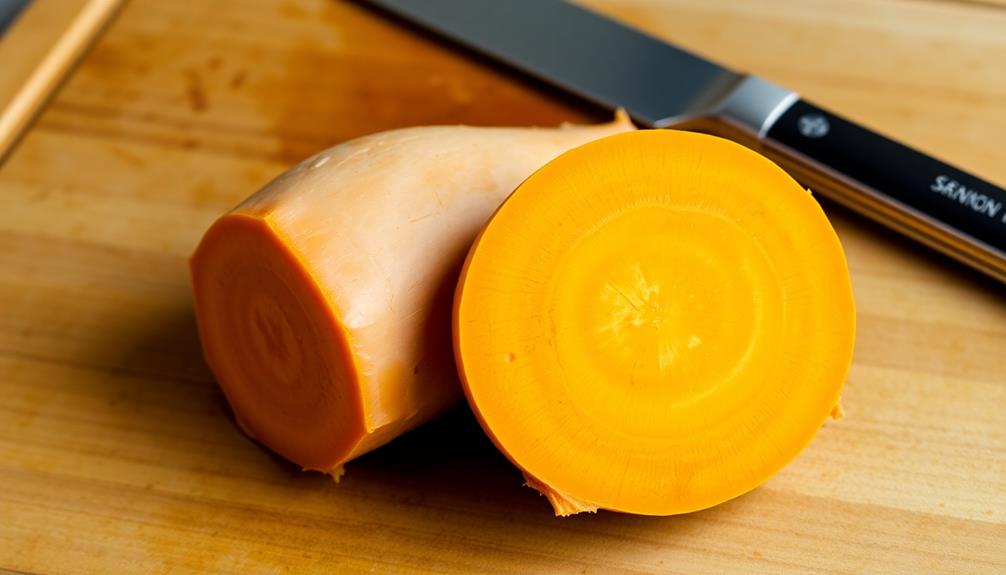You'll love how crispy and delicious these homemade yam chips are! Yams are native to Africa and the Americas, and ancient voyagers even carried them on their Pacific adventures. Today, you can make your own yam chips at home – they're a tasty twist on the classic snack that's packed with natural sweetness and nutrition. Slice the yams, toss them in oil, and bake at 400°F for 18-22 minutes. The results are golden brown, crispy chips that are perfect for sharing as a side, snack, or appetizer. And you'll be surprised by all the health benefits yams provide – learn more about their fascinating history and versatility.
Key Takeaways
- Crispy yam chips offer a healthier alternative to traditional potato chips, providing a natural sweetness and satisfying crunch.
- Achieving the perfect crispy texture requires even slicing and thorough drying before frying or baking the yam slices.
- The baking process at 400°F for 18-22 minutes, with flipping halfway, ensures the yam chips are golden brown and crispy.
- Yams are a versatile ingredient, featuring in various cultural dishes and traditions, especially in the Caribbean and Asia.
- Homemade yam chips are a nutritious snack option, packed with vitamins, minerals, and antioxidants from the yam's natural goodness.
History

Yams, the starchy roots that inspired these crispy chips, have a long and varied history. Native to Africa and the Americas, yams have been a dietary staple for centuries. In fact, ancient Polynesian voyagers even carried yams with them as they explored the Pacific!
These versatile vegetables come in a rainbow of colors, from vibrant orange to deep purple.
Throughout history, yams have played a central role in many cultural traditions. In the Caribbean, they're a beloved ingredient in festive dishes, while in parts of Asia, they're revered for their medicinal properties.
And of course, who could forget the classic Thanksgiving yam casserole, complete with marshmallows?
Today, yams are enjoyed around the world, often transformed into delectable snacks like these crispy yam chips.
Recipe

Yam chips are a delightful and crunchy snack that can be enjoyed as a healthier alternative to traditional potato chips. The natural sweetness of the yams pairs beautifully with the satisfying crunch achieved through proper preparation.
To ensure the perfect crispy texture, it's essential to slice the yams evenly and thoroughly dry them before frying. This step is crucial in achieving the desired crispness, as any moisture can lead to soggy chips.
Ingredients:
- 2 medium-sized yams, peeled and sliced into 1/8-inch thick rounds
- 2 cups vegetable or canola oil for frying
- Salt to taste
Cooking Instructions:
Heat the oil in a large, heavy-bottomed pan or Dutch oven to 350°F. Working in batches, carefully add the yam slices to the hot oil and fry for 2-3 minutes, or until golden brown and crispy.
Remove the chips from the oil using a slotted spoon and transfer them to a paper towel-lined plate to drain excess oil. Sprinkle with salt while still hot.
It's important to note that the key to achieving the perfect crispy yam chips is to maintain the oil temperature and fry the slices in small batches. This ensures even cooking and prevents the chips from becoming soggy.
Serve the crispy yam chips immediately for optimal crunch and enjoy!
Cooking Steps

Preheat your oven to 400°F and get ready to slice those yams into thin, round slices.
Toss the slices with a bit of oil, then arrange them on a baking sheet.
Now bake them until they're crispy and golden – you're going to love these tasty yam chips!
Step 1. Preheat Oven to 400°F

Before you begin slicing and baking the yams, you'll want to preheat your oven to 400°F. This is a crucial first step to ensure your yam chips turn out crispy and delicious. Preheating the oven allows it to reach the perfect temperature, which helps the yams to bake evenly and develop that irresistible crunch.
Once your oven is preheated, you'll be ready to slice the yams and get them in the oven. Be sure to keep an eye on the chips as they bake, checking them periodically to ensure they don't overcook.
The high temperature will work its magic, transforming the yams into golden-brown, crispy perfection. Preheating the oven is an essential part of the process, so don't skip this step.
With the oven ready to go, you'll be one step closer to enjoying those mouthwatering, homemade yam chips!
Step 2. Slice Yams Into Thin Rounds

With your oven preheated, you can now grab your fresh yams and start slicing them into thin, even rounds.
Grab a sharp knife and carefully slice the yams about 1/4 inch thick. Try to make each slice the same thickness so they'll bake evenly.
As you slice, lay the yam rounds in a single layer on a large baking sheet. Don't overcrowd them, or they won't get crispy.
Once all the slices are on the baking sheet, you're ready for the next step.
Remember to work slowly and safely with the knife. Taking your time will help you get those perfect, uniform slices.
Soon, you'll have a tray full of yummy yam rounds, just waiting to be transformed into crispy, golden-brown chips.
Get ready for the delicious aroma to fill your kitchen as these babies bake to perfection!
Step 3. Toss Yam Slices With Oil

Now that you have your tray of neatly sliced yam rounds, it's time to get them ready for baking. In a large bowl, drizzle the yam slices with a few tablespoons of olive oil.
Use your clean hands to gently toss the yams, making sure each slice is lightly coated. Don't be afraid to get in there and get a little messy – it's all part of the fun!
Next, arrange the oiled yam slices in a single layer on a baking sheet lined with parchment paper. This will help them get extra crispy as they bake.
Make sure the slices aren't overlapping, so they've plenty of room to become the perfect golden-brown chips you're craving.
With the yams all prepped and ready, it's time to pop them in the oven. Preheat to 400°F and let those delicious yam morsels work their magic.
Get ready for the most irresistible, crispy yam chips you've ever had!
Step 4. Arrange Yam Slices on Baking Sheet

Next, arrange the oiled yam slices in a single layer on a baking sheet lined with parchment paper. This will help prevent the yams from sticking and ensure they cook evenly.
Make sure the slices don't overlap, as that can prevent them from getting crispy. Spread them out with a little bit of space in between each one.
Now, pop that baking sheet into a preheated oven. The high heat is the key to getting those yam slices perfectly crispy on the outside while still tender on the inside.
Keep a close eye on them, as they can go from perfectly golden to burnt in the blink of an eye. Rotate the baking sheet halfway through the cooking time to ensure even browning.
Once the yam chips are sizzling and irresistibly crispy, it's time to take them out of the oven.
Get ready to enjoy this tasty, healthier alternative to traditional potato chips!
Step 5. Bake Until Crispy and Golden

Preheat your oven to 400°F (200°C). This is the perfect temperature to get those yam slices crispy and golden!
Arrange the slices in a single layer on a parchment-lined baking sheet. Make sure they're not overlapping, so they can get nice and crispy all around.
Now, pop that sheet into the oven and let the magic happen. Bake for 18 to 22 minutes, flipping the slices halfway through. Keep a close eye on them, as yams can go from perfectly crispy to burnt in the blink of an eye!
You'll know they're ready when they're a beautiful golden brown and you can easily pierce them with a fork.
Once they're done, take the sheet out of the oven and let the chips cool for a few minutes. This will help them get even crispier.
Grab a plate, pile on those delectable yam chips, and get ready for a snack that's out of this world!
Final Thoughts

Crispy yam chips make a versatile and satisfying snack. Whether you're hosting a party or craving a healthier alternative to traditional potato chips, these crunchy delights won't disappoint.
The best part? They're a breeze to prepare at home. Simply slice the yams, toss them in oil, and bake until golden. The result is a batch of irresistibly crispy, flavorful chips that will have your taste buds dancing.
Serve them up as a side dish, a movie-night snack, or even a fun appetizer. They pair perfectly with a variety of dips and toppings, from savory ranch to sweet and tangy fruit salsa.
And let's not forget the health benefits – yams are packed with vitamins, minerals, and antioxidants, making them a nutritious choice for the whole family.
Frequently Asked Questions
What Is the Best Way to Store Leftover Yam Chips?
To store leftover yam chips, place them in an airtight container or resealable plastic bag. This will help maintain their crispness and prevent them from getting soggy. Refrigerate them for up to 3-5 days for best quality.
How Long Do Homemade Yam Chips Last?
Homemade yam chips can last up to 5 days when stored properly in an airtight container at room temperature. However, they'll stay crispier for longer if you refrigerate them.
Can I Use a Different Type of Potato Instead of Yam?
Absolutely! You can use other types of potatoes, like russet or sweet potatoes, to make delicious homemade chips. The cooking process will be similar, but the flavor and texture may vary slightly. Feel free to experiment with different potato varieties.
Is It Possible to Bake Yam Chips in the Air Fryer?
Absolutely! You can definitely bake yam chips in the air fryer. The air fryer's circulating hot air will help create a deliciously crispy texture, making it a fantastic alternative to traditional deep-frying.
What Are Some Tasty Dipping Sauces for the Yam Chips?
For your delicious yam chips, you can whip up some tasty dipping sauces like a creamy garlic aioli, a sweet and tangy honey mustard, or a fiery chipotle mayo to complement the natural sweetness of the yams.










